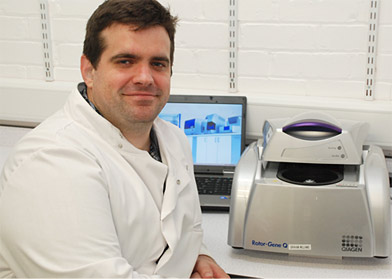New forensic science research will aid rape cases
Tue, 03 Jul 2012 13:10:00 BST
Huddersfield researcher Graham Williams pioneers the measurement of RNA

A FORENSIC scientist at the University of Huddersfield has made a breakthrough which is set to make a major impact on the investigation and prosecution of sex offences.
By developing new techniques which enable him to tell precisely which body fluid is the source of a DNA sample, Graham Williams (pictured) believes that the rate of successful prosecutions in rape cases – widely deemed to be far too low – could rise dramatically. Also, miscarriages of justices could be avoided if it can be shown that an accused person did not carry out a sexual assault.
After four years of research, Mr Williams – formerly a forensic scientist for the Home Office, investigating hundreds of cases – has developed a technique incorporating Real Time PCR. It analyses samples, such as fingernail scrapings, by measuring RNA, which is a single-stranded equivalent to DNA.
This enables him to achieve much greater analytic precision. Conventional DNA techniques can state that a person’s body fluid is present in a sample, but cannot state which fluid it is. Graham Williams is now in a position to show that an RNA sample comes from a fluid such as blood, saliva or vaginal material.
In cases of alleged rape, the issue of ‘withdrawn consent’ is often crucial, says Mr Williams. For example, consensual oral intercourse could be followed by non-consensual vaginal intercourse. A penile swab of an alleged rapist might show that the DNA of the victim to be present, but this could be inconclusive. Now Mr William’s techniques enable him to show whether that DNA is from saliva or vaginal material.
The breakthrough is of potential importance to both the prosecution and defence side of cases. Mr Williams – who has lectured and researched at the University of Huddersfield since 2007 – expects that forensic science labs will begin to adopt his techniques, especially once they have been accepted as part of court proceedings. One way he hopes to accelerate this is by inviting approaches from defence lawyers who could see his hyper-precise new method of body fluid analysis as a means of exonerating clients.
Mr Williams has presented his findings to the 2012 conference of the American Academy of Forensic Sciences, attended by more than 4,000 global experts. He revealed that in rigorously controlled tests his “single stream” method – analysing DNA and RNA simultaneously – produced correct identifications of body fluids. Also, the process reduces the potential for contamination of evidence and it is cost-effective.
His conference presentation was well-received and Mr Williams is shortly to publish his findings.







